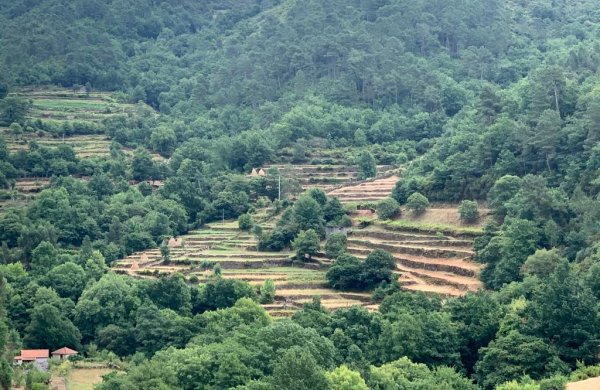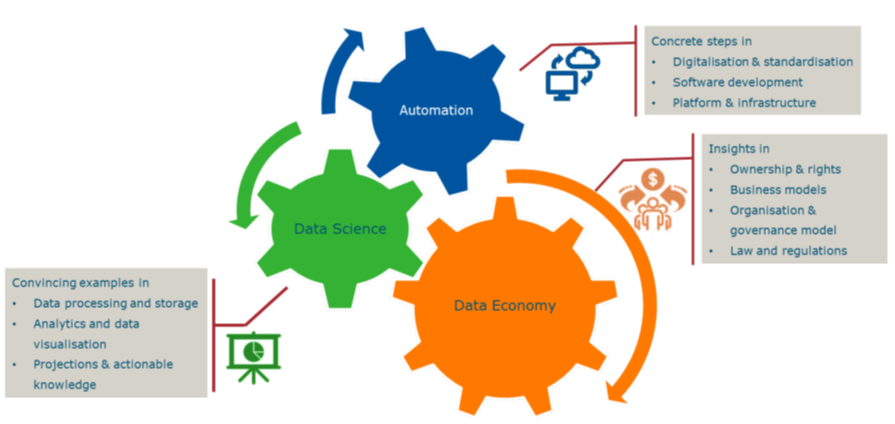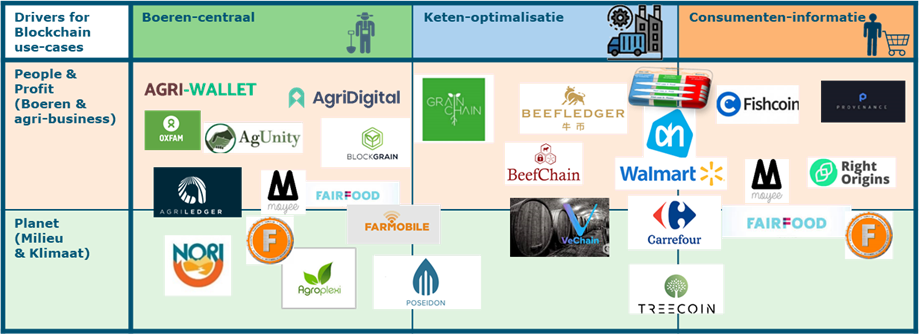
Longread
Blockchain for agri-food: on the road to scale-up
The potential of blockchain for agri-food has been a frequent topic of discussion in scientific literature and the media since 2017. In recent years, the number of scientific and professional articles on this topic has continued to grow. What are the most recent developments in the realm of blockchain applications? What opportunities and challenges does the technology present to the agri-food sector in the Netherlands? And what would help blockchain applications grow and accelerate? This longread takes a realistic look at the current landscape, best practices and key problems, and considers how blockchain could be scaled up in future.
Blockchain for agri-food: from hype to infrastructure
The agri-food sector in the Netherlands is facing some substantial challenges. Farmers, horticulturalists and other value chain participants are under tremendous pressure to operate more sustainably and to account for their sustainability efforts. Consumers want more information on the origin and quality of food. These challenges need innovative responses, including the use of innovative technologies such as blockchain.
Blockchain is receiving a lot of interest for its potential to solve issues related to trust in all sorts of transactions. Back in 2016, it was already anticipated that blockchain technology would gain significance, even in the agri-food sector. Blockchain initiatives are now springing up all over the world. International organisations such as FAO and the WTO are paying a lot of attention to the technology. In the Netherlands, too, the potential of blockchain is being actively explored by both the government and private sector. A number of initiatives are investigating the technology and are experimenting with it through various use cases. They include the Ministry of Agriculture, Nature and Food Quality (LNV) programme ‘Blockchain for agri-food’, the Public Private Partnership project (PPP) ‘Blockchain: Automated Compliance in Agri-food chains’, and the Strike Two community. Alliances such as the Dutch Blockchain Coalition (DBC) have been established with the objective of creating a safe and reliable infrastructure for blockchain applications.
The playing field for blockchain applications
Blockchain is a collection of information technologies and agreements that allows a network of people and organisations to maintain a common, shared data system. It’s therefore often referred to as Distributed Ledger Technology (DLT), which is a more generic concept than blockchain. It’s important to note that it’s not just a distributed system, but also an autonomous one. The system cannot be modified or stopped. That’s a fundamental characteristic of blockchain technology.
The blockchain playing field consists of a variety of IT-related and economic spheres. Blockchain is essentially an information technology for the exchange of data and information between different parties. The playing field for blockchain applications involves three sub-data worlds made up of automation, data science and the economics of data. Figure 1 shows the main features of a blockchain application.

The term is used not just for ledgers but also for applications in general. But it’s always about essentially autonomous software systems that are hosted by a variety of organisations. From a logical perspective, it’s one system operating in a decentralised way.
Blockchain applications don’t share very many common characteristics, apart from the fact that all blockchain applications consist of three layers:
- Blockchain technologies: distributed ledger + consensus mechanism + cryptography
- Blockchain governance: who decides what will be in the ledger, choice of blockchain type and platforms, access to and rights in the blockchain ledger
- Blockchain ecosystem: cooperating players with different concerns, interests and roles, and anticipated outcomes.
What are the issues and topics at play?
From a strategic and policymaking perspective, blockchain is relevant to agri-food in terms of:
- Transparency in sustainability and contribution to climate objectives and circular agriculture (monitoring of KPIs in sustainability, emissions, soil/water/air conditions, preventing and combating fraud in areas such as fertiliser transport)
- Traceability for food safety and value chain optimisation (prompt recalls in emergencies, reduction of food waste)
- Information for consumers (origin and quality of food, fair prices for food products, health, climate impact and contribution to climate objectives)
- The position of farmers and revenue models in the data economy (access to data infrastructures, governance, regulations on data exchange)
Where are we now? - The current landscape
Blockchain was initially seen mainly as fin-tech and something for the financial sectors to use. Banks and insurance companies were the first sectors to start experimenting with it. The logistics and energy sectors soon followed. Since 2017, interest in blockchain has also rapidly been growing in the agri-food sector. The opportunities and challenges around blockchain for agri-food have now been discussed in different reports and a large number of academic papers and reviews (see, for example, Sylvester 2019, Motta et al. 2020, Tiwari 2020, Sendros, Drosatos et al. 2022).
In 2017, one could still count the number of use cases for agri-food on one hand, but in 2020, the number and variety of blockchain applications grew enormously, and that trend continued in 2021 and beyond. More than 40 blockchain platforms are now active in the agri-food sector. Our earlier study had already found more than 35 use cases that had gone beyond the Proof of Concept (PoC) phase. Many others were also in the roll-out phase. Figure 2 shows the geographic spread. The thematic spread is shown in Figure 3.

Opportunities and challenges
Opportunities for blockchain in agri-food are summarised in Table 1, based on available literature. A number of use cases see blockchain as ‘the single layer of truth’, framing it as a tool for improving transparency and traceability in agri-food chains. This is particularly evident in the applications under the ‘value chain optimisation’ category. In the climate and environment sector however, utility tokens are an important factor in enabling new business and governance models.
The application of innovative technologies usually generates some resistance and obstructions. Blockchain is still fairly new and in many aspects is indeed still in its infancy. There are challenges and key problems at both the technological and organisational levels.
The technological challenges of blockchain have been discussed at length in technical and academic research (Upadhyay 2020). The organisational challenges tend to be related to governance – each application often needs a bespoke solution. There’s also a lot of debate in the legal sphere about blockchain’s admissibility as a normative technology (Schellekens et al. 2019). Importantly, there’s broad recognition that blockchain poses a challenge of technological and organisational complexity. Smart contracts, for example, are difficult to understand or monitor without specialist knowledge, and it’s expensive to bring in that expertise but also risky to trust that the contract does what the developer claims.
The key challenges in the application of blockchain for agri-food are:
- Dealing with the complexity and governance of the technology: It’s often unclear what exactly people understand blockchain to be, as there are different types of blockchain and different aspects of blockchain applications.
- Getting past the chicken-and-egg problem: There’s a wide divergence of perceptions and expectations around the advantages of blockchain, and these are difficult to prove unless people are willing to make serious investments in terms of time, money and process change. But without that proof, many people will have trouble committing to blockchain.
- Linking blockchain to existing databases and legacy systems: Farmers and horticulturalists already have a patchwork of digital platforms to deal with. The added value of blockchain isn’t clear.
Towards scale-up
The application of innovative technology opens up an important role for the government to promote initiatives and experiments that contribute to the achievement of societal objectives and to facilitate mutual learning between different experiments. Public-Private Partnerships (PPPs) are also an essential way of ensuring broad application and adoption. Furthermore, it’s helpful for existing use cases to be supported with working prototypes and ecosystems and to encourage their scaling up. In particular, governments need to encourage the development of standards for defining data and use cases. The use of standards is important for interoperability between blockchain applications and efficient data exchange between different blockchains.
It would also be helpful for the government to use policy instruments such as the Dutch Digitalisation Strategy to support and encourage use cases with research and development capacity, particularly in terms of the further development of model use cases with working prototypes such as FarmDataWallet, Flori-Chain and AGF-Chain.
This will require a focus on the following issues:
- Encouraging the use of standard messaging (such as e-Lab in the AGF-Chain use case), interfaces between different systems (in particular between RVO, NVWA, CTGB, e-CertNL, and crop registration systems such as CropVision and Dacom Farm Intelligence)
- Reducing certification costs (audit, inspection, data accreditation and validation) for growers and other parties in agri-food chains by using AI for data validation
- Demonstrating how blockchain works (‘playgrounds’) and identifying obstacles for farmers and other parties in their digital transition to the data economy
- Preventing ethical key problems by ensuring strong governance agreements
- Developing an accreditation and validation system for blockchain data (‘Oracle’)
The implementation of blockchain applications goes hand in hand with a range of technological and organisational changes that form an essential part of achieving more transparent and efficient forms of collaboration. As many people have already found, it’s a complex process. However, there are practical steps that we can take to unleash the potential of blockchain for a sustainable agri-food sector. It’s up to all of us to make it happen.
